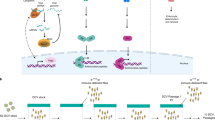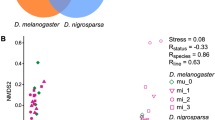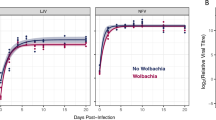Abstract
The identification of host factors that control susceptibility to infection has been hampered by a lack of amenable genetic systems. We established an in vivo model to determine the host factors that control pathogenesis and identified viral entry as a rate-limiting step for infection. We infected Drosophila melanogaster cells and adults with drosophila C virus and found that the clathrin-mediated endocytotic pathway is essential for both infection and pathogenesis. Heterozygosity for mutations in genes involved in endocytosis is sufficient to protect flies from pathogenicity, indicating the exquisite sensitivity and dependency of the virus on this pathway. Thus, this virus model provides a sensitive and efficient approach for identifying components required for pathogenesis.
This is a preview of subscription content, access via your institution
Access options
Subscribe to this journal
Receive 12 print issues and online access
$209.00 per year
only $17.42 per issue
Buy this article
- Purchase on Springer Link
- Instant access to full article PDF
Prices may be subject to local taxes which are calculated during checkout




Similar content being viewed by others
References
Alcami, A. & Koszinowski, U.H. Viral mechanisms of immune evasion. Immunol. Today 21, 447–455 (2000).
Ploegh, H.L. Viral strategies of immune evasion. Science 280, 248–253 (1998).
Biron, C.A. Initial and innate responses to viral infections—pattern setting in immunity or disease. Curr. Opin. Microbiol. 2, 374–381 (1999).
Guidotti, L.G. & Chisari, F.V. Noncytolytic control of viral infections by the innate and adaptive immune response. Annu. Rev. Immunol. 19, 65–91 (2001).
Cooke, G.S. & Hill, A.V.S. Genetics of susceptibility to human infectious disease. Nat. Rev. Genet. 2, 967–977 (2001).
Samson, M. et al. Resistance to HIV-1 infection in caucasian individuals bearing mutant alleles of the CCR-5 chemokine receptor gene. Nature 382, 722–725 (1996).
Nomoto, A., Koike, S. & Aoki, J. Tissue tropism and species specificity of poliovirus infection. Trends Microbiol. 2, 47–51 (1994).
Goodbourn, S., Didcock, L. & Randall, R.E. Interferons: cell signalling, immune modulation, antiviral response and virus countermeasures. J. Gen. Virol. 81, 2341–2364 (2000).
Lee, S.H. et al. Susceptibility to mouse cytomegalovirus is associated with deletion of an activating natural killer cell receptor of the C-type lectin superfamily. Nat. Genet. 28, 42–45 (2001).
Rueckert, R.R. in Fields Virology (eds. Fields, B.N., Knipe, D.M. & Howley, P.M.) 609–654 (Lippincott-Raven, Philadelphia, 1996).
Johnson, K.N. & Christian, P.D. Molecular characterization of Drosophila C virus isolates. J. Invertebr. Pathol. 73, 248–254 (1999).
Fields, B.N., Knipe, D.M. & Howley, P.M. Virology (Lippincott-Raven, Philadelphia, 2001).
Moore, N.F., Pullin, J.S., Crump, W.A. & Plus, N. The proteins expressed by different isolates of Drosophila C virus. Arch. Virol. 74, 21–30 (1982).
Klasse, P.J., Bron, R. & Marsh, M. Mechanisms of enveloped virus entry into animal cells. Adv. Drug Deliv. Rev. 34, 65–91 (1998).
Bayer, N. et al. Effect of bafilomycin A1 and nocodazole on endocytic transport in HeLa cells: implications for viral uncoating and infection. J. Virol. 72, 9645–9655 (1998).
Carrasco, L. Picornavirus inhibitors. Pharmacol. Ther. 64, 215–290 (1994).
Takei, K. & Haucke, V. Clathrin-mediated endocytosis: membrane factors pull the trigger. Trends Cell Biol. 11, 385–391 (2001).
Narayanan, R. & Ramaswami, M. Endocytosis in Drosophila: progress, possibilities, prognostications. Exp. Cell Res. 271, 28–35 (2001).
Lloyd, V., Ramaswami, M. & Kramer, H. Not just pretty eyes: Drosophila eye-colour mutations and lysosomal delivery. Trends Cell Biol. 8, 257–259 (1998).
Lautie-Harivel, N. & Thomas-Orillard, M. Location of Drosophila C virus target organs in Drosophila host population by an immunofluorescence technique. Biol. Cell 69, 35–39 (1990).
Chen, M.S. et al. Multiple forms of dynamin are encoded by shibire, a Drosophila gene involved in endocytosis. Nature 351, 583–586 (1991).
van der Bliek, A.M. & Meyerowitz, E.M. Dynamin-like protein encoded by the Drosophila shibire gene associated with vesicular traffic. Nature 351, 411–414 (1991).
Damke, H., Binns, D.D., Ueda, H., Schmid, S.L. & Baba, T. Dynamin GTPase domain mutants block endocytic vesicle formation at morphologically distinct stages. Mol. Biol. Cell 12, 2578–2589 (2001).
Moline, M.M., Southern, C. & Bejsovec, A. Directionality of wingless protein transport influences epidermal patterning in the Drosophila embryo. Development 126, 4375–4384 (1999).
Vidal, S. et al. Mutations in the Drosophila dTAK1 gene reveal a conserved function for MAPKKKs in the control of rel/NF-κB-dependent innate immune responses. Genes Dev. 15, 1900–1912 (2001).
Jousset, F.X., Plus, N., Croizier, G. & Thomas, M. [Existence in Drosophila of 2 groups of picornavirus with different biological and serological properties]. C R Acad. Sci. Hebd. Seances Acad. Sci. D 275, 3043–3046 (1972).
Plus, N., Croizier, G., Jousset, F.X. & David, J. Picornaviruses of laboratory and wild Drosophila melanogaster: geographical distribution and serotypic composition. Ann. Microbiol. (Paris) 126, 107–117 (1975).
Thomas-Orillard, M., Jeune, B. & Cusset, G. Drosophila-host genetic control of susceptibility to Drosophila C virus. Genetics 140, 1289–1295 (1995).
Plus, N., Croizier, G., Reinganum, C. & Scott, P.D. Cricket paralysis virus and drosophila C virus: serological analysis and comparison of capsid polypeptides and host range. J. Invertebr. Pathol. 31, 296–302 (1978).
Miller, L.K. & Ball, A.L. The Insect Viruses (eds. Fraenkel-Conrat, H. & Wangner, R.R.) (Plenum, New York, 1998).
Gomariz-Zilber, E., Poras, M. & Thomas-Orillard, M. Drosophila C virus: experimental study of infectious yields and underlying pathology in Drosophila melanogaster laboratory populations. J. Invertebr. Pathol. 65, 243–247 (1995).
Johnson, K.N. & Christian, P.D. The novel genome organization of the insect picorna-like virus Drosophila C virus suggests this virus belongs to a previously undescribed virus family. J. Gen. Virol. 79, 191–203 (1998).
Koyama, A.H. et al. Suppression of apoptotic and necrotic cell death by poliovirus. J. Gen. Virol. 82, 2965–2972 (2001).
Tucker, S.P., Thornton, C.L., Wimmer, E. & Compans, R.W. Vectorial release of poliovirus from polarized human intestinal epithelial cells. J. Virol. 67, 4274–4282 (1993).
Kandolf, R., Selinka, H. & Klingel, K. in Molecular Biology of Picornaviruses (eds. Semler, B.L. & Wimmer, E.) 405–413 (ASM Press, Washington, DC, 2002).
Mellman, I. Endocytosis and molecular sorting. Annu. Rev. Cell. Dev. Biol. 12, 575–625 (1996).
DeTulleo, L. & Kirchhausen, T. The clathrin endocytic pathway in viral infection. EMBO J. 17, 4585–4593 (1998).
Marsh, M. & Pelchen-Matthews, A. Endocytosis in viral replication. Traffic 1, 525–532 (2000).
Damke, H., Baba, T., van der Bliek, A.M. & Schmid, S.L. Clathrin-independent pinocytosis is induced in cells overexpressing a temperature-sensitive mutant of dynamin. J. Cell Biol. 131, 69–80 (1995).
Krishnan, K.S. et al. Nucleoside diphosphate kinase, a source of GTP, is required for dynamin- dependent synaptic vesicle recycling. Neuron 30, 197–210 (2001).
DiAntonio, A., Parfitt, K.D. & Schwarz, T.L. Synaptic transmission persists in synaptotagmin mutants of Drosophila. Cell 73, 1281–1290 (1993).
Littleton, J.T., Stern, M., Perin, M. & Bellen, H.J. Calcium dependence of neurotransmitter release and rate of spontaneous vesicle fusions are altered in Drosophila synaptotagmin mutants. Proc. Natl. Acad. Sci. USA 91, 10888–10892 (1994).
Littleton, J.T. et al. Synaptotagmin mutants reveal essential functions for the C2B domain in Ca2+-triggered fusion and recycling of synaptic vesicles in vivo. J. Neurosci. 21, 1421–1433 (2001).
Haucke, V. & De Camilli, P. AP-2 recruitment to synaptotagmin stimulated by tyrosine-based endocytic motifs. Science 285, 1268–1271 (1999).
von Poser, C. et al. Synaptotagmin regulation of coated pit assembly. J. Biol. Chem. 275, 30916–30924 (2000).
Haucke, V., Wenk, M.R., Chapman, E.R., Farsad, K. & De Camilli, P. Dual interaction of synaptotagmin with m2- and a-adaptin facilitates clathrin-coated pit nucleation. EMBO J. 19, 6011–6019 (2000).
Ferguson, G.D., Anagnostaras, S.G., Silva, A.J. & Herschman, H.R. Deficits in memory and motor performance in synaptotagmin IV mutant mice. Proc. Natl. Acad. Sci. USA 97, 5598–5603 (2000).
Fernandez-Chacon, R. et al. Synaptotagmin I functions as a calcium regulator of release probability. Nature 410, 41–49 (2001).
Acknowledgements
We thank P. Christian for viral reagents, and members of the Perrimon lab, M. Gonzalez-Gaitan, J.T. Littleton, J.-M. Reichhart and T. Schwarz for fly strains. We thank M. Tudor for statistical analysis and discussions, and H. Ploegh, C. Roman, B. Stronach, E. Selva, L. van Parijs and S. Whelan for discussions and for critically reading the manuscript. We thank J. Kopinja and C. Villalta for injections, and S. Armknecht, and L. Hrdlicka for technical assistance. Supported by a National Institutes of Health National Research Service Award (S.C.) and RO1-AI051365-01A1.
Author information
Authors and Affiliations
Corresponding author
Ethics declarations
Competing interests
The authors declare no competing financial interests.
Supplementary information
Rights and permissions
About this article
Cite this article
Cherry, S., Perrimon, N. Entry is a rate-limiting step for viral infection in a Drosophila melanogaster model of pathogenesis. Nat Immunol 5, 81–87 (2004). https://doi.org/10.1038/ni1019
Received:
Accepted:
Published:
Issue Date:
DOI: https://doi.org/10.1038/ni1019
This article is cited by
-
Real-time analysis of quantum dot labeled single porcine epidemic diarrhea virus moving along the microtubules using single particle tracking
Scientific Reports (2019)
-
RNase III nucleases from diverse kingdoms serve as antiviral effectors
Nature (2017)
-
In vivo and in vitro infection dynamics of honey bee viruses
Scientific Reports (2016)
-
Analysis of resistance and tolerance to virus infection in Drosophila
Nature Protocols (2015)
-
RNA-mediated interference and reverse transcription control the persistence of RNA viruses in the insect model Drosophila
Nature Immunology (2013)



